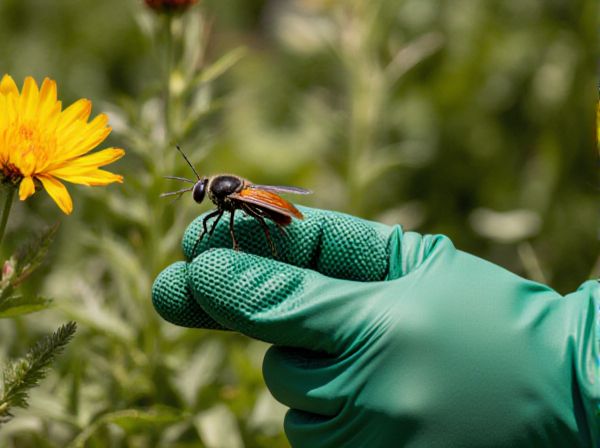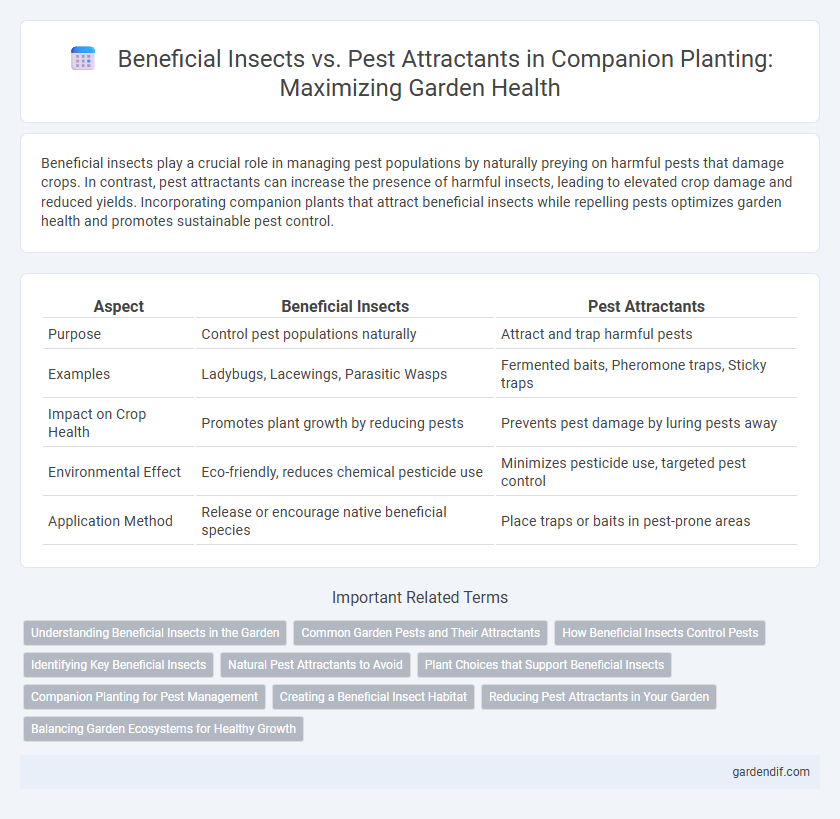
Beneficial insects vs pest attractants Illustration
Beneficial insects play a crucial role in managing pest populations by naturally preying on harmful pests that damage crops. In contrast, pest attractants can increase the presence of harmful insects, leading to elevated crop damage and reduced yields. Incorporating companion plants that attract beneficial insects while repelling pests optimizes garden health and promotes sustainable pest control.
Table of Comparison
| Aspect | Beneficial Insects | Pest Attractants |
|---|---|---|
| Purpose | Control pest populations naturally | Attract and trap harmful pests |
| Examples | Ladybugs, Lacewings, Parasitic Wasps | Fermented baits, Pheromone traps, Sticky traps |
| Impact on Crop Health | Promotes plant growth by reducing pests | Prevents pest damage by luring pests away |
| Environmental Effect | Eco-friendly, reduces chemical pesticide use | Minimizes pesticide use, targeted pest control |
| Application Method | Release or encourage native beneficial species | Place traps or baits in pest-prone areas |
Understanding Beneficial Insects in the Garden
Beneficial insects such as ladybugs, lacewings, and parasitic wasps play a crucial role in controlling pest populations by preying on aphids, caterpillars, and other harmful garden pests. Understanding their behavior and habitat preferences helps gardeners attract and sustain these natural predators, reducing the need for chemical pesticides. Incorporating flowering plants like dill, fennel, and marigolds provides nectar and shelter, creating an ideal environment for beneficial insects to thrive.
Common Garden Pests and Their Attractants
Companion planting targets common garden pests like aphids, whiteflies, and beetles by using beneficial insects such as ladybugs and lacewings, which prey on these pests and reduce their populations naturally. Plants like marigolds emit scents that repel nematodes and whiteflies, while attracting pollinators and predatory insects that protect crops. Utilizing the balance between beneficial insects and pest attractants optimizes pest control and enhances garden health without chemical interventions.
How Beneficial Insects Control Pests
Beneficial insects such as ladybugs, lacewings, and parasitic wasps effectively control pests by preying on harmful insects like aphids, caterpillars, and whiteflies, reducing the need for chemical pesticides. These natural predators contribute to maintaining ecosystem balance and promote healthy plant growth through biological pest control. Encouraging habitats for beneficial insects supports sustainable agriculture by enhancing crop resilience and minimizing pest population outbreaks.
Identifying Key Beneficial Insects
Key beneficial insects such as ladybugs, lacewings, and predatory wasps play a crucial role in controlling pest populations by preying on aphids, mites, and caterpillars. Identifying these beneficial insects involves recognizing their distinct physical traits, such as the red and black spots on ladybugs or the delicate, veined wings of lacewings. Understanding the behaviors and habitats of these insects helps differentiate them from common pest attractants like aphids and whiteflies, enhancing effective companion planting strategies.
Natural Pest Attractants to Avoid
Natural pest attractants such as excessive nitrogen-rich fertilizers, overripe fruits, and dense ground cover can inadvertently draw harmful insects like aphids, whiteflies, and beetles into the garden. Avoiding these conditions helps maintain a balanced ecosystem where beneficial insects such as ladybugs, lacewings, and parasitic wasps thrive, effectively controlling pest populations. Selecting companion plants that repel pests, like marigolds and nasturtiums, further supports natural pest management without disrupting beneficial insect activity.
Plant Choices that Support Beneficial Insects
Selecting diverse flowering plants such as marigolds, dill, and fennel is crucial for attracting beneficial insects like ladybugs, lacewings, and parasitic wasps that naturally control pest populations. Incorporating native nectar-rich plants enhances pollinator activity and improves ecosystem balance by providing habitat and food sources for predatory insects. Avoiding plants that emit pest-attractant chemicals minimizes infestation risks while maximizing the presence of beneficial insects for effective companion planting strategies.
Companion Planting for Pest Management
Companion planting leverages beneficial insects such as ladybugs, lacewings, and parasitic wasps to naturally suppress pest populations like aphids and caterpillars in gardens. Certain plants, including marigolds and nasturtiums, act as pest attractants by drawing harmful insects away from valuable crops, reducing pest damage. Integrating these pest-repellent and attractant plants creates a balanced ecosystem that enhances pest management and promotes healthier plant growth.
Creating a Beneficial Insect Habitat
Creating a beneficial insect habitat involves planting diverse flowering plants that provide nectar and pollen to sustain pollinators and predatory insects. Incorporating native plants and avoiding broad-spectrum pesticides enhances the survival of beneficial insects, which naturally suppress pest populations. This ecological balance reduces the need for chemical interventions and promotes healthier garden or crop environments.
Reducing Pest Attractants in Your Garden
Beneficial insects such as ladybugs and lacewings thrive in gardens with diverse plantings that minimize pest attractants like decaying plant matter and excessive nitrogen fertilizers. Incorporating companion plants such as marigolds and basil naturally repels pests by disrupting their scent trails and reducing the presence of aphids and whiteflies. Maintaining proper garden hygiene and balanced soil nutrition further decreases pest-attracting conditions, fostering a habitat where beneficial insects can effectively control harmful populations.
Balancing Garden Ecosystems for Healthy Growth
Beneficial insects such as ladybugs, lacewings, and predatory wasps play a crucial role in controlling pest populations like aphids and caterpillars, promoting a balanced garden ecosystem. Employing companion planting techniques with attractants like marigolds, herbs, and flowering plants can draw these beneficial insects while repelling harmful pests. Maintaining this balance reduces the need for chemical pesticides, leading to healthier plant growth and improved biodiversity in the garden.
Beneficial insects vs pest attractants Infographic

 gardendif.com
gardendif.com